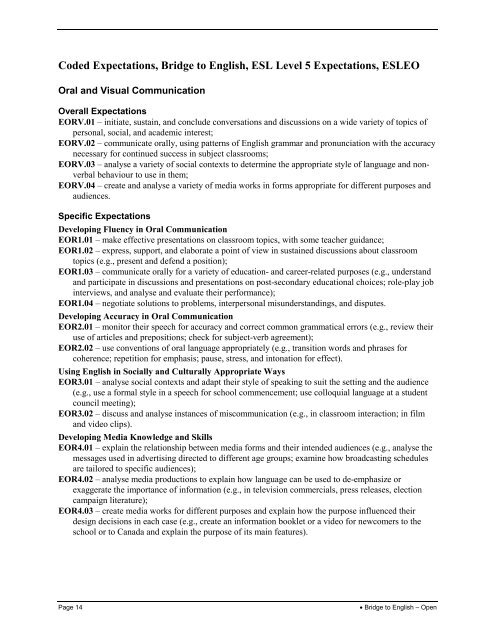Course Profile - Curriculum Services Canada
Course Profile - Curriculum Services Canada
Course Profile - Curriculum Services Canada
You also want an ePaper? Increase the reach of your titles
YUMPU automatically turns print PDFs into web optimized ePapers that Google loves.
Coded Expectations, Bridge to English, ESL Level 5 Expectations, ESLEO<br />
Oral and Visual Communication<br />
Overall Expectations<br />
EORV.01 – initiate, sustain, and conclude conversations and discussions on a wide variety of topics of<br />
personal, social, and academic interest;<br />
EORV.02 – communicate orally, using patterns of English grammar and pronunciation with the accuracy<br />
necessary for continued success in subject classrooms;<br />
EORV.03 – analyse a variety of social contexts to determine the appropriate style of language and nonverbal<br />
behaviour to use in them;<br />
EORV.04 – create and analyse a variety of media works in forms appropriate for different purposes and<br />
audiences.<br />
Specific Expectations<br />
Developing Fluency in Oral Communication<br />
EOR1.01 – make effective presentations on classroom topics, with some teacher guidance;<br />
EOR1.02 – express, support, and elaborate a point of view in sustained discussions about classroom<br />
topics (e.g., present and defend a position);<br />
EOR1.03 – communicate orally for a variety of education- and career-related purposes (e.g., understand<br />
and participate in discussions and presentations on post-secondary educational choices; role-play job<br />
interviews, and analyse and evaluate their performance);<br />
EOR1.04 – negotiate solutions to problems, interpersonal misunderstandings, and disputes.<br />
Developing Accuracy in Oral Communication<br />
EOR2.01 – monitor their speech for accuracy and correct common grammatical errors (e.g., review their<br />
use of articles and prepositions; check for subject-verb agreement);<br />
EOR2.02 – use conventions of oral language appropriately (e.g., transition words and phrases for<br />
coherence; repetition for emphasis; pause, stress, and intonation for effect).<br />
Using English in Socially and Culturally Appropriate Ways<br />
EOR3.01 – analyse social contexts and adapt their style of speaking to suit the setting and the audience<br />
(e.g., use a formal style in a speech for school commencement; use colloquial language at a student<br />
council meeting);<br />
EOR3.02 – discuss and analyse instances of miscommunication (e.g., in classroom interaction; in film<br />
and video clips).<br />
Developing Media Knowledge and Skills<br />
EOR4.01 – explain the relationship between media forms and their intended audiences (e.g., analyse the<br />
messages used in advertising directed to different age groups; examine how broadcasting schedules<br />
are tailored to specific audiences);<br />
EOR4.02 – analyse media productions to explain how language can be used to de-emphasize or<br />
exaggerate the importance of information (e.g., in television commercials, press releases, election<br />
campaign literature);<br />
EOR4.03 – create media works for different purposes and explain how the purpose influenced their<br />
design decisions in each case (e.g., create an information booklet or a video for newcomers to the<br />
school or to <strong>Canada</strong> and explain the purpose of its main features).<br />
Page 14<br />
• Bridge to English – Open

















